SATURDAY’S CHILDREN
A play by Karyn Traut
Cited in the 1992 Aetna Calendar of Black History
for having a black actor play Thomas Jefferson at the ArtsCenter in Carrboro, NC in 1988
NOW A FILM
Of the actual play
Written, produced and directed by Karyn Traut
Director of Photography Michael Noble
Featuring
Greacian Goeke, Kim Herold, Thomasi MacDonald, John Murphy and Wiley Rinaldi
Sculpture by Tom Traut
Original Score by Richard Robeson
Costumes by Hannah Andrews
Assistant Producer, Andrea Sumner;
Lighting Designer, Alton Chewning;
Script and Continuity, Andrea Staats;
Audio, Ben Turney;
Assistant Camera, Cindy Hsieh,
Puppets by Jeff Storer and Rhonda Pumphreys
Comments made by audience members after the private viewing:
I like it that you didn't tell us how to think.
I will never think about Thomas Jefferson the same again!
It has so many levels…which I like.
There is so much complexity of photography, of character, of dialogue…
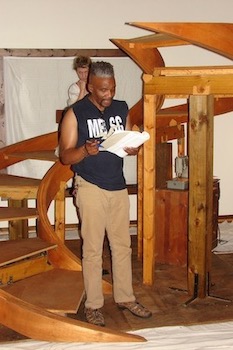
Thomasi MacDonald rehearsing the part of Harold, who is deciding whether to play Jefferson.
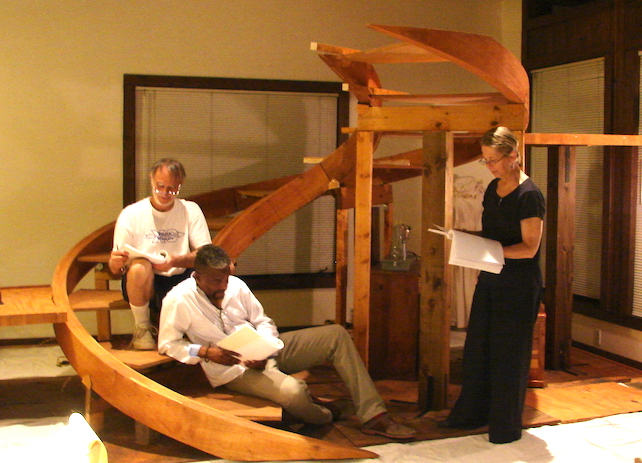
The spiral staircase is the center for the action
in this play. Here, Wiley Rinaldi, Thomasi MacDonald, and Graecian Goeke are in rehearsal.
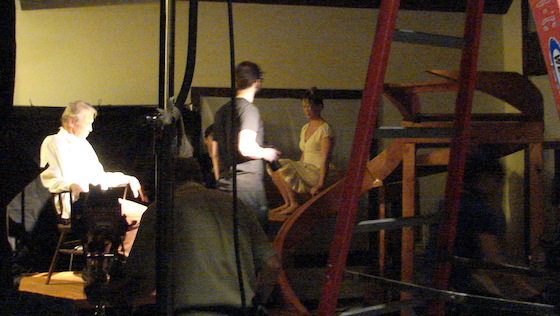
John Murphy, who plays 'The Real Jefferson', at far left. Michael Noble, director of photography (back to camera).
About the Play
The title, Saturday's Children, refers to the expansive clock that Jefferson designed and built over the entrance door at Monticello, to tell the day of the week. The clock displayed the days of the week: Sunday, Monday, and so on. When mounted, the clock's weights and balance allowed only room for six days on the descending wall. So Jefferson had a hole cut in the floor for the weight to gravitate through the floor to the basement where the descending weight could reach "Saturday." Hence "Saturday's Children" are the people left in the basement of the American Dream, represented by Jean, Harold and Arthur.
The problem the contemporary characters face is how to get "Saturday" out of the basement of the remarkable clock (which serves as a metaphor for American Democracy) designed and constructed over the existing floorboards of Monticello (which serves as a metaphor for the pre-revolution political system.
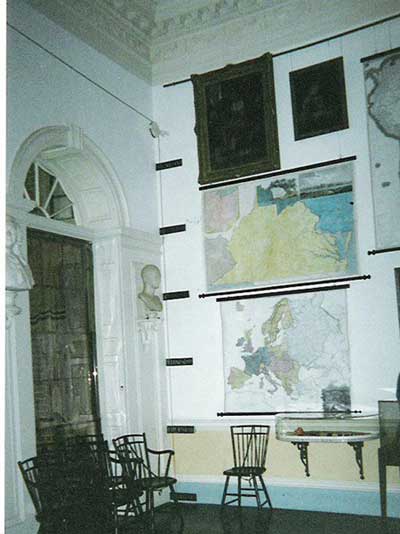
The clock is above the door, and to the left of the horizontal cable for weights. The dark plates on the wall at right are for names of weekdays, with Sunday at the top, and Friday just above the floor.
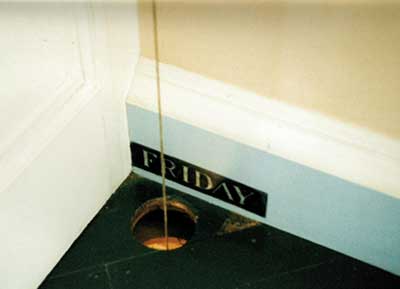
A close up view of Friday.
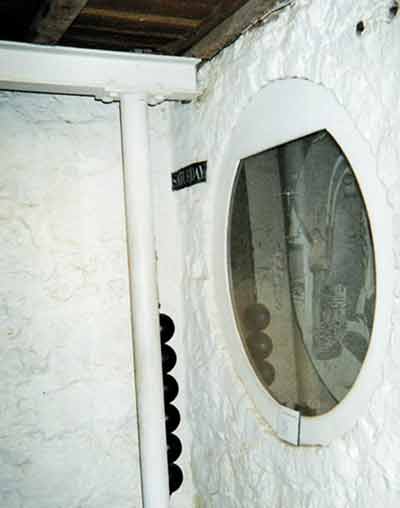
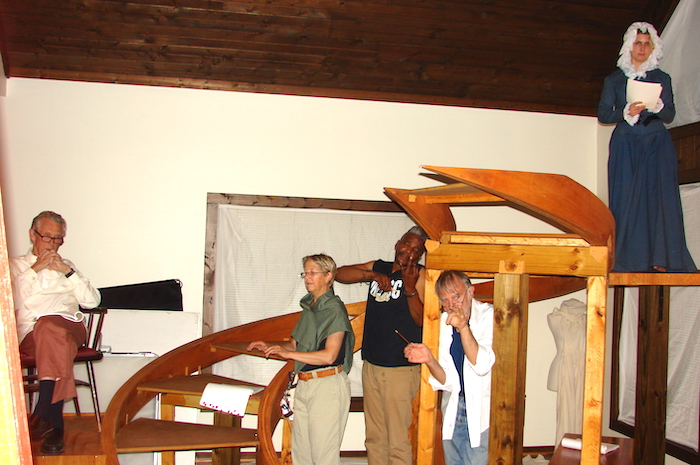
Cast rehearsing the romantic courtship scene in which, Harold as Jefferson and Greacian as his future wife, Martha, play a violin and piano forté duet. Wiley as Arthur prepares to work puppets. 'The Real Jefferson' 'remembers' and Jefferson's daughter, Martha, reads from her writing. Note: The blocking of the duet changed for the final shoot.
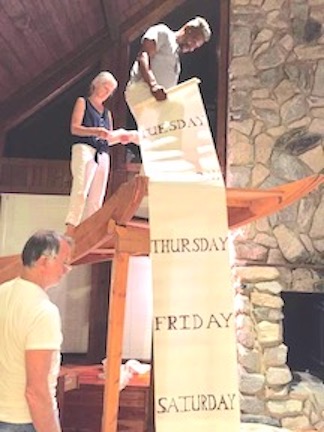
Reviews of the 1988 stage production at the ArtsCenter in Carrboro:
"Had she chosen to be a mere iconoclast, Ms. Traut could have had a field day, judging Jefferson by our late-20th-century sensibilities concerning race and sex . . . she had a different aim: sandblasting some of the myths that obscure the MAN like multiple layers of old cheap paint." -- Robert McDowell; Raleigh News & Observer (1988)
"the Jefferson women, . . . unfazed by their ancestor's 'greatness', offer a sense of the day-to-day Jefferson . . . that Harold, a black actor employed to play the role of Jefferson, twice attaches an effigy of the great man to his chest is fraught with significance." --Dorrie Casey; Leader Magazine (1988)
Controversial Perspective
Saturday's Children departed from an accepted view that supposes Thomas Jefferson to be the father of his slave, Sally Hemings' children. During playwright Karyn Traut's seven years of research that preceded the writing of the script, it appeared to her that the most likely father of Sally Hemings' children was Thomas Jefferson's brother, Randolph. This novel view was consistent with
the DNA evidence a decade later. Though the journal Nature incorrectly headlined that the DNA proved Thomas Jefferson fathered ‘slaves last child’, whereas the article itself reveals that . the DNA was taken from descendants of Field Jefferson, Thomas Jefferson’s uncle, and as such, Thomas Jefferson’s brother, Randolph Jefferson, and several cousins were equally implicated.
As Jean and Harold argue things out, the three contemporary characters take on the parts of historic figures with Harold regularly playing Jefferson himself. As points are made, the "real Jefferson" or the "Jefferson women" respond from actual writings. Thus a dialogue across time occurs and adds to the dimension and exploration of the argument.
Once again, Saturday's Children made history by being listed in the Jefferson-Hemings Scholars Commission Report as a pre-DNA-test public presentation of the model of Randolph as the progenitor of the Eston Hemings line. Eston was Sally's last child and the one linked by the DNA to the Jefferson male line through the descendants of Thomas and Randolph's uncle, Field Jefferson. Saturday's Children includes, but is not centered on, the issue of Sally Hemings and her children.
Because members of the Scholars Commission were made aware of Karyn's research and pre-DNA test production in 1988, she became a consultant to the Scholars Commission. Thomas Traut, professor of biochemistry at the UNC-CH School of Medicine, was asked to be a full member of the commission to explain the DNA findings to the historians.
Letter to the Washington Post:
Link to article in South Writ Large:
Link to Endeavors Magazine article:
We feel the time is ripe for this film . . .
In fact…the time may always be right for a perusal of our iconic and controversial founder
The United States is a country founded on an idea. It is not, as are many other countries, a collection of residents of a particular geographic region or genetic stock. If we lose sight of our founding ideals, we lose the bedrock of our character.
Thomas Jefferson put words to the ideals of the Founding Fathers in the Declaration of Independence, and continued to advise, throughout his life, in letters to active statesmen, on the principles of liberty. In a letter to James Madison, December 20, 1787, he wrote from Paris, where he was serving as the American Plenipotentiary to France, his assessment of the American Constitution:
"I will now tell you what I do not like. First the omission of a bill of rights providing clearly, and without the aid of sophism, for freedom of religion, freedom of the press, protection against standing armies, restriction of monopolies, the eternal and unremitting force of the habeas corpus laws, and trials by jury in all matters of fact."
The heated controversy over the paternity of Sally Hemings' children has distracted many Americans from Thomas Jefferson's writings about issues that are still of vital importance to all Americans.
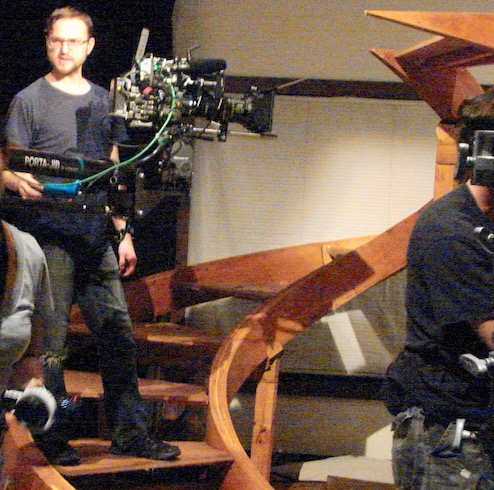
Director of Photography, Michael Noble, setting up a shot
Spiral staircase
Designed and built by Tom Traut
Tom Traut building the spiral staircase: the risers (beams) are made to form a spiral by using sheets of 5 mm plywood which is flexible enough to curve around a pre-built cylinder, or barrel, with the exact dimensions for the inside riser (pictures 1 and 2), or for the outside riser (pictures 3 and 4).
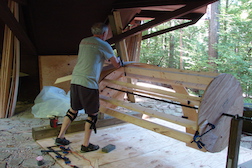
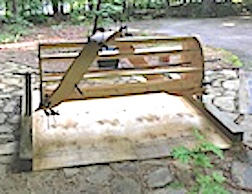
2) The completed inside riser.
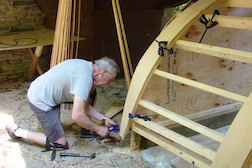
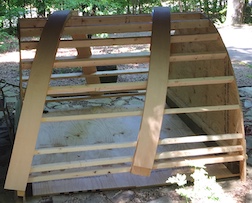
4) The 2 halves of the outside riser.
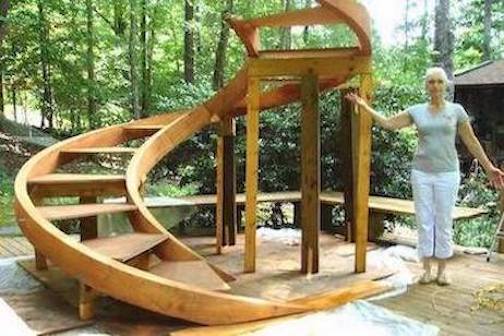
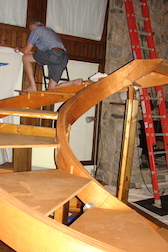
6) The staircase was then disassembled, and re-built on the set for the film.